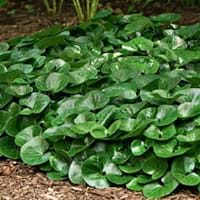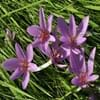About Meadow Saffron and European Wild Ginger
Life Span
Perennial
Annual and Perennial
Type
Bulb or Corm or Tuber
Broadleaf Evergreen
Origin
Hybrid origin
Western Europe
Types
boissieri , cupanii , hungaricum , kesselringii
Not Available
Number of Varieties
Not Available
Habitat
Temperate Regions
gardens, Lake Sides, Marshy ground, shade of upland trees, Shaded sites, Subtropical climates
USDA Hardiness Zone
Not Available
4-8
AHS Heat Zone
Not Available
Not Available
Sunset Zone
21,22
Not Available
Habit
Clump-Forming
Spreading
Flower Color
Purple, Violet
Green, Purple, Brown
Flower Color Modifier
Bicolor
Bicolor
Fruit Color
Not Available
Not Available
Leaf Color in Spring
Green
Dark Green
Leaf Color in Summer
Light Green
Dark Green
Leaf Color in Fall
Several shades of Green
Dark Green
Leaf Color in Winter
Light Green
Dark Green
Leaf Shape
Long Linear
Cushion
Plant Season
Spring, Fall
Spring, Summer, Fall, Winter
Sunlight
Full Sun, Partial Sun
Partial shade, Full Shade
Growth Rate
Medium
Medium
The pH of Soil
Acidic, Neutral
Acidic, Neutral
Soil Drainage
Well drained
Well drained
Bloom Time
Late Summer, Early Fall
Late Spring
Tolerances
Drought
Not Available
Where to Plant?
Ground
Container, Ground
How to Plant?
Divison, From bulbs, Seedlings
Divison, Rhizome division
Plant Maintenance
Medium
Low
Watering Requirements
Keep ground moist
Average Water Needs
In Summer
Lots of watering
Average Water
In Spring
Moderate
Moderate
In Winter
Average Water
Average Water
Soil pH
Acidic, Neutral
Acidic, Neutral
Soil Drainage Capacity
Well drained
Well drained
Sun Exposure
Full Sun, Partial Sun
Partial shade, Full Shade
Pruning
no pruning required
Don't prune in winter, Prune in spring, Remove dead branches, Remove dead leaves
Fertilizers
All-Purpose Liquid Fertilizer
All-Purpose Liquid Fertilizer
Pests and Diseases
Dry root rot, Pest Free
Ants, Slugs, Snails
Plant Tolerance
Drought
Not Available
Flowers
Showy
Insignificant
Flower Petal Number
Single
Not Available
Foliage Texture
Coarse
Medium
Foliage Sheen
Glossy
Glossy
Attracts
Whiteflies
Insects
Allergy
Poisonous to grazing animals
no allergic reactions
Aesthetic Uses
along a porch, deck or patio, Borders, Mixed Border, small hedge
Showy Purposes
Beauty Benefits
No Beauty Benefits
No Beauty Benefits
Environmental Uses
Air purification
Air purification
Medicinal Uses
anti rheumatic, cathartic
Ear ache, Fever, Heart problems, Menstrual Disorders, Snakebite
Part of Plant Used
Root
Whole plant
Other Uses
Showy Purposes
Not Available, Used in making tooth powder
Used As Indoor Plant
No
No
Used As Outdoor Plant
Yes
Yes
Garden Design
Container, Cutflower, Foundation, Lawns and Turf, Mixed Border
Edging, Groundcover
Botanical Name
COLCHICUM 'Lilac Wonder'
ASARUM europaeum
Common Name
Hybrid Autumn Crocus, Hybrid Meadow Saffron
European Wild Ginger
In Hindi
meadow saffron
यूरोपीय जंगली अदरक
In German
Herbstzeitlose
Europäische Wild Ginger
In French
Colchique d'automne
Wild Ginger européenne
In Spanish
Estado de conservación
Wild Ginger Europea
In Greek
meadow saffron
Ευρωπαϊκή Wild Ginger
In Portuguese
Colchicum autumnale
Wild Ginger Europeia
In Polish
Colchicum autumnale
Kopytnik pospolity
In Latin
autumnale
Gingiberi Europae Wild
Phylum
Tracheophyta
Magnoliophyta
Class
Magnoliopsida
Magnoliopsida
Family
Liliaceae
Aristolochiaceae
Clade
Angiosperms, Monocots
Angiosperms, Magnoliids
Tribe
Not Available
Not Available
Subfamily
Not Available
Not Available
Number of Species
Not Available
Not Available
Properties of Meadow Saffron and European Wild Ginger
Wondering what are the properties of Meadow Saffron and European Wild Ginger? We provide you with everything About Meadow Saffron and European Wild Ginger. Meadow Saffron doesn't have thorns and European Wild Ginger doesn't have thorns. Also Meadow Saffron does not have fragrant flowers. Meadow Saffron has allergic reactions like Poisonous to grazing animals and European Wild Ginger has allergic reactions like Poisonous to grazing animals. Compare all the properties and characteristics of these two plants. Find out which of these plant can be used as indoor plant. If you are interested to decorate your house and garden, find out aesthetic uses, compare them and select the plant which will beautify your surrounding. Along with beautification, try comparing medicinal and edible uses of Meadow Saffron and European Wild Ginger and you can choose the plant having best and most benefits.
Season and Care of Meadow Saffron and European Wild Ginger
Season and care of Meadow Saffron and European Wild Ginger is important to know. While considering everything about Meadow Saffron and European Wild Ginger Care, growing season is an essential factor. Meadow Saffron season is Spring and Fall and European Wild Ginger season is Spring and Fall. The type of soil for Meadow Saffron is Loam and for European Wild Ginger is Loam while the PH of soil for Meadow Saffron is Acidic, Neutral and for European Wild Ginger is Acidic, Neutral.
Meadow Saffron and European Wild Ginger Physical Information
Meadow Saffron and European Wild Ginger physical information is very important for comparison. Meadow Saffron height is 12.70 cm and width 20.30 cm whereas European Wild Ginger height is 6.35 cm and width 27.30 cm. The color specification of Meadow Saffron and European Wild Ginger are as follows:
Meadow Saffron flower color: Purple and Violet
Meadow Saffron leaf color: Green
European Wild Ginger flower color: Green, Purple and Brown
- European Wild Ginger leaf color: Dark Green
Care of Meadow Saffron and European Wild Ginger
Care of Meadow Saffron and European Wild Ginger include pruning, fertilizers, watering etc. Meadow Saffron pruning is done no pruning required and European Wild Ginger pruning is done Don't prune in winter, Prune in spring, Remove dead branches and Remove dead leaves. In summer Meadow Saffron needs Lots of watering and in winter, it needs Average Water. Whereas, in summer European Wild Ginger needs Average Water and in winter, it needs Average Water.





